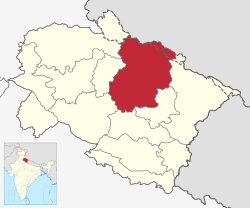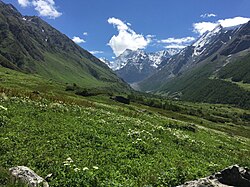Recreation
Living in the mountains mostly in places that are not easily accessible, the people of the district have been able to preserve their culture, folklore, folksongs and folk dances, the last, a distinctive feature of the district, being seasonal, traditional and religious, some of the better known being described below.
The Thadiya dance, which is accompanied by song, is performed on Basant Panchami, the festival celebrating the advent of Spring, the Mela, another dance, is perform on Deepawali and the Pandava during the winter after the harvesting of the crop and depicts the principal events of the Mahabharata. Other folk dances are Jeetu Bhagdawal and Jagar or Ghariyali. These dances enact mythological stories, the participants, both men and women, put on their traditional colourful dress and dance to the tune of drums and Ransinghas. Another dance performed during the fairs and accompanied by song is the Chanchari, in which both men and women participate.
Folk songs are usually traditional and are sung particularly by the women, who work very hard in the fields from morning till night in all kind of weather. During the month of Chaitra the women of the village gather at a central place and sing traditional song which generally relate deeds of heroism, love and the hard life which they have to lead in the hills. In the district, fairs, festivals, religious and social gatherings are the main occasions for recreation and amusement. On special occasions people arrange swangs (open air dramatic performances) particularly depicting scenes or legends connected with Shiva and Parvati.
Fairs and festivals
Festivals play an important role in the life of people in the district, as elsewhere, and are spread over the entire year, the most important being briefly described below.
Ram Navami falls on the ninth day of the bright half of Chaitra to celebrate the birthday of Rama. The followers of Rama in the district observe fast throughout the day and the Ramayana is read and recited and people gather to listen to the recitations.
Nag Panchmi is celebrated in the district on the fifth day of the bright half of Sravana to appease the Nagas or serpent gods. Figures of snakes are drawn in flour in wooden boards and are worshipped by the family by offering milk, flowers and rice.
Raksha-Bandhan is traditionally associated with the Brahmanas and falls on the last day of Sravana. On this occasion a sister ties a Rakshasutra (thread of protection)—commonly known as Rakhi—round the right wrist of her brother in token of the protection she expects to receive from him. Fairs are held on this occasion at Kedarnath, Karnaprayag and Nandprayag.
Janmastami – the festival celebrating the birth of Krishna, falls on the eighth day of the dark half of Bhadra. As in other parts of the state, devotees in the district fast the whole day, breaking their fast only at mid-night when worshipers throng the temples and foregather to have a Jhanki (glimpse) of the shrines and cradles specially installed, decorated and illuminated in homes and other places to commemorate the deity's birth. A special feature of this festival is the singing of devotional songs in praise of Krishna in shrines and homes. The Chhati (sixth-day ceremony after birth) is also celebrated by the devout. The festival is celebrated with great enthusiasm at Nagnath, Badrinath and Kedarnath.
Dusshera – falls on the tenth day of the bright half of Asvina and commemorates the victory of Rama over Ravana, the preceding nine days being celebrated as Navaratri dedicated to the worship of the goddess Durga. Ramlila celebrations are held at different places in the district particularly at Kalimath.
Dipawali – the festival of lights, is celebrated in the district, as elsewhere, on the last day of the dark half of Kartika when the houses are illuminated and the goddess Lakshmi is worshipped. Festivities start two days earlier, with Dhanteras, when metal utensils are purchased as a token of the desired prosperity, followed by Naraka Chaturdashi when a few small earthen lamps are lit as a preliminary to the main day of festival. For traders and businessmen Dipawali marks the end of the fiscal year and they pray for prosperity in the new year. On this occasion the people of the district perform mela nritya, a type of folk dance, a distinctive feature of the district.
Makar Sankranti – a bathing festival which falls either on 13 or 14 January when people take bath in the Alaknanda and big fairs (Uttarayni) are held at Karanprayag and Nandprayag.
Shiv-ratri – falls on the 14th day of the dark half of Phalgun and is observed in the honour of Shiva. People fast throughout the day and a vigil is kept at night when the deity is worshipped. The Shiva temples are specially decorated and illuminated and large numbers of devotees offer water and flowers to the symbols and images of Shiva and sing devotional songs in his praise. Big fairs are held on this occasion at most of the Shiva temples of the district particularly at Dewal, Bairaskund, Gopeshwar, and Nagnath.
Holi – the spring festival, is celebrated on the full moon day of Phalgun. People start singing Phaags (Songs of Phalgun) during the nights, long before the festival. A flag or banner is installed at a central place in the village on the 11th day of bright of Phalgun and is burnt on the 15th day which is known as Chharoli when ash mark is put on the foreheads of friends and relatives. The following day is marked by common rejoicing when, till about noon, people throw coloured water and coloured powder on each other and in evening visit relatives and friends.
Many fairs are held in the district, the important ones being mentioned below.
On the 13th day of April every year the big fair known as Bishwat Sankranti is held in the district. This fair is also mentioned in the Pandukeshwar inscription of Lalitashuradeva issued in the 22nd regnal year. It is also held at Ming (14 April), Aser (15 April), Hans Koti (16 April), and Kulsari and Adbadri (17 April). Another important fair of the district is the Gaucher Mela held at Gaucher in Karnprayag in the month of November every year and is attended by number of persons. Others fairs of importance are the Nautha at Adbadri, Naumi at Hariyali, Nanda Devi at Bedni, Dattatreya Pooranmasi at Ansuya temple, Nagnath at Dewar Walla.
Nanda Devi Raj Jaat – Nanda Raj Jaat, the big pilgrimage of Nandadevi, is unique to Chamoli. It is very old traditional pilgrimage from the time of shalipal in the ninth century. There are no historical records but it is gathered from the local folklores and folksongs (jagori) that Shahipal who had his capital at Chandpur Garhi, buried a tantric instrument at Nauti nearby, and installed his patron-goddess Nandadevi (Raj Rajeshwari) there. The Royal priest, Nautiyal, of Nauti was made responsible for regular worship of the goddess.
King Shahipal started a tradition that a big pilgrimage (Nanda Raj Jat) would bw organised every twelfth year to escort Nandadevi to her in-law's place, near Nanda Ghungti peak. When the capital was shifted by Ajay Pal, Kunwar (the younger brother of the king), who gad settled at Kansuwa nearby, was authorised to organise Raj Jat on behalf of King.
Traditionally the Kunwar comes to Nauti to seek the blessing of the Devi to organise the Jat. A four horned ram takes birth in Kasuwa area thereafter. A time schedule is drawn up for the Jat so as to reach Homkund on the Nandashtami day in August/September, and Kulsari on the preceding new moon for special worship.
Accordingly, the Kunwar reaches Nauti with the four horned ram and ringal [18] -umbrella. The Raj Jat starts on the long round-trek of about 280 km. with 19 halts on the way, taking about 19 days. Bhumiyal, Ufrai and Archana Devis are worshipped prior to the departure. The golden image of Nandadevi is carried in a silver palanquin and thousands of devotees follow in a long procession.
Great festivities and religious observances mark the Jaat wherever they halt or pass through. The procession swells as it advances with various groups joining from far and near with their idols and umbrellas. Special mention may be made of those coming from kurud from Ghat, Lata near Tapovan and Almora in Kumaon. Some 300 idols and decorated umbrellas assembles at Wan, en route Hemkund.
Mass participation and religious devotion are unmatched, for the Jat involves a long and arduous journey over treacherous terrains rising to an altitude of 5,335 m at Jiura Gali Dhar from a near 900 m at Nauti, walking barefoot over snow and moraines and passing through deep forests.
At Shail Samundra the pilgrims see three lights and a streak of smoke just before dawn as a divine beckon.
Surprisingly the four horned ram, loaded with the offerings for the goddess, guides the procession of devotees from the Nauti till it reaches Hemkund, near the base of Nanda Ghungti, resting every night near the Nauti umbrella of the goddess. At Hemkund it manifests human emotions and tears are seen in its eyes before it leaves everyone behind to get lost towards the mountains, laden with the offering of the devotees for the goddess Nandadevi.
There is a unique custom of keeping everyone's house unlocked in Wan village for the use of the yatris on the Jat day, according to the divine instruction of the goddess Nandadevi, and it is followed religiously. The last NandaDevi Raj Jat was held during August/September 2000. Smaller Raj Jaats are organised annually from Kurud village near Ghat, covering a smaller circuit in August–September.







